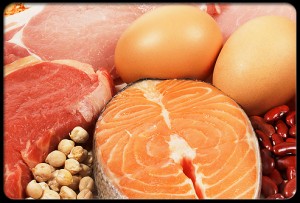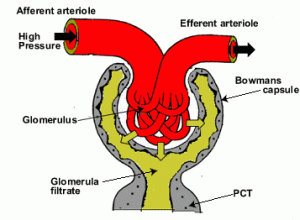
August 24, 2013
High Protein Intake: Myths and Misconceptions About Safety (Part 1)
Read pretty much any academic nutrition text and you’ll get the same-old same-old about high-protein diets being harmful to your health. The concerns center around everything from cardiovascular disease to kidney function to bone resorption. Question is, are these claims grounded in science or are they mostly hyperbole?

We can dismiss the cardiovascular claims offhand as they are based on consumption of ketogenic diets. The issue here is not with protein intake per se but rather with saturated fat. Let’s be clear: you can have a high protein intake without consuming large amounts of dietary fat. They are not necessarily tied to one another. Lean poultry, fish and beef have a low fat content. So any discussion about cardiovascular issues should be relegated to dietary fat consumption irrespective of protein intake (and for the record, there is much dispute as to whether saturated fat actually plays a role in atherosclerosis – but that’s a topic for another day).
That out of the way, I’ll delve into the other areas of contention. In this post I’ll cover the effects of a high protein intake on kidney function. In Part II I’ll explore the impact on bone. Okay, let’s dig in.
The claim that a high protein intake is detrimental to the kidneys has been attributed to Dr. Barry Brenner, a physician at Brigham and Women’s Hospital. A little background is in order to understand the purported issues. The metabolism of protein entails a complex sequence of events for proper assimilation to take place. During digestion, protein is broken down into its component parts, the amino acids (via a process called deamination). A byproduct of this occurrence is the production of ammonia, a toxic substance, in the body. Ammonia, in turn, is rapidly converted into the relatively non-toxic substance urea in the liver, which is then transported to the kidneys for excretion. The excretory process initially takes place in an area of the kidneys called the glomerulus, where waste is filtered through a large network of capillaries.

Brenner proposed that the associated urea production from excessive protein intake overloads the glomerulus, thereby causing renal injury and dysfunction. This became known as the “Brenner Hypothesis.” Brenner’s work in the area was published in the prestigious New England Journal of Medicine and the hypothesis subsequently became gospel in academic nutritional circles.
Here’s the rub: Brenner’s hypothesis was based on data from animal studies and those with existing renal disease. And as any good scientist knows, you cannot necessarily extrapolate such results to a healthy population.
An examination of the literature shows that, within wide limits, there is no evidence that a diet high in protein has any detrimental effects on those with normal renal function. Healthy kidneys are readily able to filter out elevated amounts of urea. In a review of research, Martin et al. concluded that “we find no significant evidence for a detrimental effect of high protein intakes on kidney function in healthy persons after centuries of a high protein Western diet.” These findings are consistent with those in a review on the effect of high protein diets in an athletic population. Studies have examined protein intakes in excess of three times the RDA without noting ill-effect. And in case you want to argue that the negative effects of protein intake on renal function take a long time to manifest and thus may not be detectable in shorter-term studies, a recent study by Lowery et al. found no markers of renal damage over a nine-year period in a cohort of healthy resistance trained subjects who consumed an average of 2.5 g/kg/day. It should be noted that increased protein consumption does lead to increases in renal size over time. However, studies show that this is a normal adaptation that has no adverse effects on kidney function.
So how much is too much? It has been postulated by some researchers that an intake greater than ~4 to 5 g/kg/day may exceed the body’s ability to convert the excess nitrogen load to urea for safe excretion. Thus, a 165 pound male would theoretically fall into the safe range at anything up to about 300 g/day; a guy weighing 220 pounds would have an upper limit of ~400 g/day. That’s *a lot* of protein! In actuality, this recommendation is probably a bit conservative. A portion of the protein you consume does not require deamination since it is directly utilized for structural remodeling of bodily tissues as well as production of hormones, enzymes, and other functions. Thus, safe levels of intake conceivably would be somewhat higher than previously thought.
Bottom line: High protein intakes may be detrimental to those with existing renal dysfunction, but there is no evidence that any negative effects are seen in individuals with healthy kidneys. Consumption of up to approximately 4 g/kg/day appears to pose no increased health risk when kidney function is normal. It’s been well-demonstrated that resistance-trained individuals require at least twice the amount of protein compared to non-lifters (although the benefit of consuming more than ~2 g/kg remains questionable from an anabolism standpoint). Moreover, higher protein intakes are beneficial for fat loss, both in terms of promoting satiety as well as reducing muscle catabolism during times of caloric restriction.
Stay tuned for Part II where I’ll discuss the claim that high protein diets are harmful to bone.
Stay Fit!
Brad
11 Comments
RSS feed for comments on this post.
Sorry, the comment form is closed at this time.





 Entries (RSS)
Entries (RSS)




I am looking forward to Part II.
I already have osteoporosis (OP) of the spine and osteopenia of the hip. The theory I see everywhere: Excess protein causes acidity, which results in mineral loss from bone. So I cut my protein, doubled my already prodigious vegetable intake, lost muscle and still have OP.
Comment by Kathleen — August 24, 2013 @ 1:53 pm
Nice article!
Comment by Evelyn aka CarbSane — August 24, 2013 @ 2:35 pm
Excellent article, Brad. Lovely breakdown of facts. Looking forward to Part ii.
Comment by Rajat — August 25, 2013 @ 12:14 am
Isn’t rabbit starvation a function of not enough fat? I ask because I’m eating around 400g of protein a day right now (GOMAD + paleo) but it’s only 30% of my diet. Fat makes up about 45-50%.
Comment by zack — August 26, 2013 @ 9:15 am
[…] 3rd CFNYC gets a shout-out in Well+Good NYC Tips make you better but tips don’t make you good High-protein intake myths & misconceptions about safety, part 1 5 best sleep-tracking gadgets or apps 6 tips to be a good […]
Pingback by Tuesday 130827 | CrossFit NYC — August 27, 2013 @ 6:30 am
[…] review: Fish oil and prostate cancer 59% of the ‘Tuna’ Americans Eat Is Not Tuna Why plenty of protein in your diet ISN’T dangerous The Economist on wild-caught vs. farmed fish A real fish story “You’re the top” […]
Pingback by Kettlebell Kitchen - Paleo. Delivered. — August 27, 2013 @ 9:05 am
Hi Zack:
Based on the literature I’ve seen, the issue in the experiment by Stefansson was with the exceedingly high protein content. Specifically, he upped the calories by consuming higher protein to offset the reduction in dietary fat (as seen in the diets of the Inuits). Now it is possible that the issues experienced by the explorers were due to other issues, but the fact remains that there is an upper limit to the nitrogen load that can be safely excreted — at some point it simply becomes too much for the body to handle.
Comment by Brad — August 27, 2013 @ 9:14 am
[…] social-physical challenges 21 Reasons Not to Join a Gym The No-So-Evils of High-Rep Weightlifting High Protein Intake: Myths and Misconceptions About Safety (Part 1) CrossFit preps Houston Texan Earl Mitchell for critical […]
Pingback by Derby City CrossFit | DarkSide Strength | Louisville Tuesday 9/3/13 - What CrossFit Can Teach You About Success — September 2, 2013 @ 9:01 pm
[…] 21 Reasons Not to Join a Gym High Protein Intake: Myths and Misconceptions About Safety (Part 1) […]
Pingback by ACF 9/18/13 | Auburn CrossFit — September 18, 2013 @ 7:02 am
[…] diets are harmful has little support, neither from an evolutionary nor scientific point of view (15,16,17). However, getting your protein from quality sources, such as grass-fed meats, free-range […]
Pingback by How Much Protein Do You Really Need? | Bret Contreras — June 12, 2014 @ 1:01 am
[…] Valkude mõju tervisele: http://www.lookgreatnaked.com/blog/high-protein-intake-myths-and-misconceptions-about-saftey-part-1/ […]
Pingback by » Toitumiskoolitus Arctic Sport Clubis :Risto Uuk — January 13, 2015 @ 11:48 am